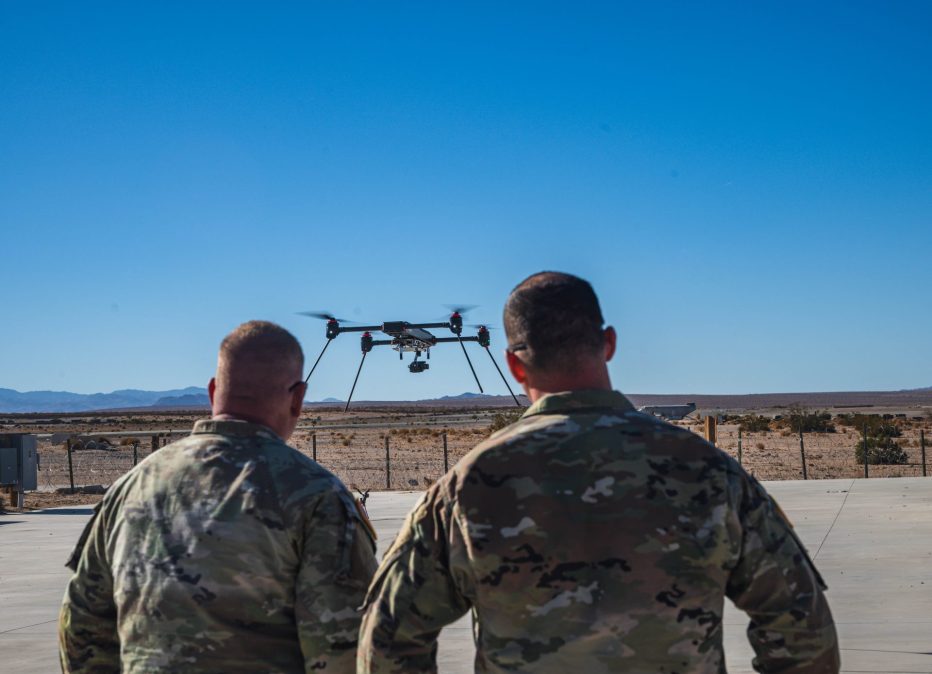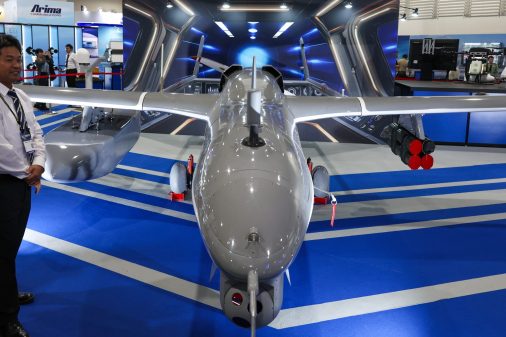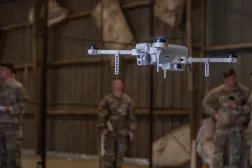Pentagon’s growing list of ‘made in America’ drones has a loophole for certain parts made in China

The Defense Department’s Blue UAS program maintains an ever-expanding index of commercial drones that are meant to be devoid of components from adversary nations including China, Russia, Iran, or North Korea, and endorsed for speedier purchasing by U.S. military buyers.
This list of compliant options is growing rapidly in late 2025 as the government moves to incentivize the adoption of more affordable U.S.-made drone products for modern military operations, and simultaneously reduce the nation’s reliance on foreign supply chains. Blue UAS also marks a key feature of the second Trump administration’s plan for “unleashing American drone dominance.”
However, multiple sources told DefenseScoop this month that the majority of the unmanned aerial systems cleared through this effort have motors that are sourced in China.
“It’s a big enough problem that we should do something. If you don’t have motors, you can’t fly a drone,” said a former senior defense official who was granted anonymity to speak freely.
“And I think if you had to pick the top three [Chinese components that are currently in Blue UAS-approved platforms], it would be the motors, the batteries and the electric speed controllers — if you want to call them, like, ‘dumb’ parts,” they noted.
In recent, separate interviews, experts who are deeply familiar with this work discussed the causes and national security implications associated with Blue UAS platforms being equipped with motors from China, and urged the U.S. drone industrial base to fully break free from adversarial supply chains.
“I definitely think that this is something that is increasingly recognized as a real challenge,” said Michael Robbin, president and CEO of the Association for Uncrewed Vehicle Systems International (AUVSI).
The ‘easy button’
AUVSI has supported the Blue UAS program in a number of ways since its origin and operates as one of the Defense Innovation Unit’s assessors that vets systems for approval.
“It doesn’t matter if it’s a motor or a battery — any kind of ‘dumb’ component still carries some risk — whether there’s something nefarious planted on it, or whether it’s just lack of resiliency in the supply chain. If the balloon goes up and we’re in a hot conflict, sea lanes are cut off, supply lines are trying to be cut off, we’re not going to have access to those motors,” he told DefenseScoop. “And if we are seeking to build one million drones, and planning on sourcing those drone parts from China, that’s a really bad strategy.”
Early roots of the DOD’s Blue UAS initiative stem back to 2018 and the launch of the U.S. Army’s Short Range Reconnaissance (SRR) program of record.
But in 2020, the Defense Innovation Unit initiated the broader “Blue sUAS” effort after Congress prohibited the department from buying or deploying certain drone components from Chinese manufacturers, and U.S. government personnel identified a dire need for an accelerated process to onboard regulation-compliant American makers of the capabilities.
Blue UAS has continued to mature since then, and now the current version of the program essentially on-boards and verifies a continuously growing inventory of different sized and types of drone platforms, parts and software to ultimately expedite their use by the military.
In June, President Donald Trump issued new policies that directed the Pentagon to arm combat units with low-cost, U.S.-made drones and integrate the capabilities into more exercises and training activities. Among multiple other directives to propel the nation’s drone industry, he also mandated federal agencies to buy more American-made UAS platforms and components for their missions.
Building on Trump’s executive orders, Defense Secretary Pete Hegseth released guidance in July that aims to shake up the DOD’s procurement processes and production pursuits to quickly ramp up its military drone arsenal and adoption.
The administration’s edicts come at a time when small uncrewed systems are increasingly proving to be game-changing on contemporary battlefields. Yet despite significant focus and investments over recent years, all of America’s military services are facing serious challenges as they hustle to deploy different-sized, affordable drones for widespread use.
“As a former soldier, it kills me to watch videos and to see soldiers soldering and building their own drones — I lose my mind,” the former senior defense official said. “I was in Special Operations and in the infantry, and I’m like, if I were told to build my own drones now, if I were still in the service, I would just be so pissed off. That’s not their job. Just give them the tool and let them go.”
Notably, DOD’s new drone directives from Trump and Hegseth have mandates that will transfer the management of Blue UAS and the “Blue List” from DIU to the Defense Contract Management Agency by Jan. 1, 2026.
That list will cover the various others previously under the Blue UAS program, including on the “Cleared” list that’s considered the official roster and the “Select” list that’s a subset of platforms meeting additional needs. More recently, companies that obtained the Green UAS certification through a separate pathway managed by AUSVI were also deemed compliant for inclusion.
Beyond that, the administration’s guidance lays out several moves for the Pentagon to incentivize the expansion and prioritization of the list for drone purchases in the near term.
Officials interviewed by DefenseScoop welcomed these changes.
But, as the military accelerates its arsenal and reliance on commercial drones in warfare, they also called on the department to tackle a “vulnerability” in Blue UAS that was unforeseen but has emerged since its inception, and is influenced by modern geopolitics and supply chain complexities.
“There’s no doubt that for many years, there was an ‘easy button’ for the global drone industry and the United States to purchase very inexpensive, very high-quality motors from China,” Robbins said. “And because the motors themselves tend to be a very low-risk security item, that was not considered to be a critical component for the purposes of Blue UAS, as Congress has mandated certain components to be non-Chinese for the warfighter.”
Critical components
Original elements of the Blue UAS program came together in the years before the Covid-19 pandemic, when the U.S. government under the first Trump administration sought to counter an upward trend in cybersecurity and technology-related espionage threats from China and elsewhere.
“We hadn’t experienced the ‘Covid shocks’ yet on the supply chain. No one had really thought about raw materials, rare earths and ‘dumb’ components, if you will. It was all about — if we have Special Operations Forces and other conventional forces in the military using Chinese drones, how can we assure that they’re protected from some sort of the backdoor, or from data going to Chinese servers, or from the Chinese being able to geofence or manipulate the drones? All those concerns were going through our minds at the time,” the former senior defense official said.
To be selected for accelerated purchasing under Blue UAS, drones and their components are vetted to be compliant with policies including Section 848 of the fiscal 2020 National Defense Authorization Act, which bans DOD from buying UAS platforms and components from “covered foreign countries.”
Officials told DefenseScoop that because non-computerized mechanical and electrical components were considered low-risk for exploitation by China at that time, the NDAA provision only called out components that store and transmit data.
That means adversary-made motors and other small electronics are excluded from the prohibition in the policy as it currently stands.
“[The lawmakers back then] were less focused on the supply chain resiliency side of this, and more on the communications elements,” Robbins said. “They focused on things that actually have a sort of communication link associated with it — and therefore were at a much higher risk. So, cameras, comms links, communication chips, and things of that nature that could potentially feed information directly back to China.”
“Motors were not considered one of those critical components. That has led to there being a very immature drone motor market outside of China,” he explained.
Bryan Clark, a senior fellow at the Hudson Institute, also noted that there’s a lack of American companies manufacturing small motors and other simple mechanical or electrical components on a global scale, because they don’t offer high profit margins and are not economical to build inside the U.S.
Clark served as a submariner before he retired from the Navy in 2008. He went on to serve in several senior civilian roles for the sea service, including special assistant to the chief of naval operations.
Now the director of Hudson’s Center for Defense Concepts and Technology, Clark recommended that Congress mandate the Pentagon to work on associated supply chain opportunities for small electronics in allied nations.
“This is fundamentally a supply chain problem. These simple components may not create a high risk of exploitation by China, but there should be U.S. sources for them,” Clark said. “Fixing this will require a combined government-industry effort to analyze alternative sources, establish relationships and contracting arrangements, and buy enough components and drones to make the economics work out for the suppliers.”
An ‘eye-watering’ problem
In September 2024, waves of explosions rocked Lebanon when thousands of pagers belonging to members of the Iran-backed Hezbollah political party and paramilitary group were unexpectedly detonated by Israeli operatives.
Dozens of people were killed and thousands were injured in that assault.
“It would be hard to incorporate an explosive into a small motor that would be capable of causing substantial damage or casualties. The Israeli pager attacks succeeded because pagers are worn on the person and a small charge can cause a lethal injury,” Clark said. “These [Blue UAS] drones will only be in direct contact with [U.S. military] personnel for a short period of time, and that time would be hard to predict or know to allow for timing an attack.”
So, he and the other experts told DefenseScoop, while physical and cybersecurity threats do exist, the most serious modern-day risks posed by Chinese-built motors on Blue UAS-approved drones are related to reliance and availability for America’s military services.
“If the Chinese can make 100 million small brushless motors a year, the U.S. industrial base might be able to make 100,000. And so if all of the sudden the Chinese stop shipping brushless motors to the United States, no one’s going to be able to build a drone. The prices for the available brushless motors are going to skyrocket. You’re going to have this huge shock for a while, and it’s going to take months and months to be able to rectify any of that. So essentially, it would halt drone production for a time,” the former senior defense official said. “That’s the availability risk.”
They noted that, because these parts are not complex machines, they don’t require high-tech manufacturing facilities or other major lifts for the government to help industry improve this situation.
“These are well-known things. But the challenge also is, if you look at a camera — even the glass is made in China at low-cost — and so it’s really hard as you continue to pull the thread on all the raw materials and everything that goes into the components, it just gets to be more of an eye-watering problem around availability,” the former senior defense official said.
They pointed to an incident last year where China made a move that demonstrated America’s dependence on its supply chains, by sanctioning the company Skydio for selling drones to Taiwan. As the official put it, China sent the U.S. company “into a frenzy for new battery providers.”
“Because, again, without a battery — without a power source — the drone doesn’t fly,” the former senior defense official said. “The Chinese are picking, and choosing when to pick, on different things. I mean, if you just look at macroeconomics, if they want to pick on the President [Donald Trump] in advance of him going to meet President Xi [Jinping], don’t buy soybeans, and that creates headlines here. And it’s something so simple. It doesn’t cause anyone physical harm. It causes economic harm, and it causes turmoil here.”
On the flip side, if the Chinese government wanted to do something similar, the official added, they could use any excuse to halt all brushless motors from leaving the nation’s ports. “And they wouldn’t even announce that. It would just happen,” they said.
Motors represent one of multiple examples of drone components where China continues to dominate international markets and present availability, cost and performance issues for the Pentagon.
“A small brushless motor is $12 to $25 per motor, from China. The best that you can find in the United States that truly are made-in-America, is like $100 to $225 per motor,” according to the former senior defense official. “So, you could buy $48 of motors from China per drone, or it’s $400 per drone for four motors in the United States.”
According to experts who spoke to DefenseScoop, one solution here involves the Pentagon buying heaps of additional drones from U.S. companies to incentivize the component-level suppliers to quickly scale.
“I think even back when we were working on this pre-Covid, we even mentioned, ‘Hey, this vulnerability is in the magnets, and in the batteries, and in the motors, and other components. And we need to invest there,’” the former senior defense official said.
Congress is appropriating money for drone acquisitions in 2026 that experts said could help raise the demand for companies to build alternative supply chains excluding American adversaries.
“The Department of Treasury put sanctions on T-Motor, which is [a Chinese company and] the largest drone motor manufacturer, because they were selling motors to Russia and Iran. And so that was like a kind of a wake-up call, I think for a lot of folks in the industry, that maybe we should not be doing business with people, and we should have alternative supply lines outside of China,” Robbins also noted.
Part of the challenge, however, is that Beijing has already flooded the global market with affordable, quality items — making it difficult for the U.S. to compete.
“There just hasn’t been a demand signal for non-Chinese motors. Now there is. And now you’re seeing companies raising money and bringing manufacturing back into the U.S., as well as in allied nations,” Robbins said.
Sources who spoke to DefenseScoop were mixed in opinions regarding whether congressional action is needed to fix this Blue UAS issue and expand the list of covered components to include smaller electronics that don’t communicate or move information.
Some suggested the Pentagon could simply mandate new companies and those that have already been certified to Blue UAS to prove that they are no longer sourcing any Chinese components for their platforms — particularly amid this transition period as the program switches from DIU to DCMA’s management and purview.
“Right now, we’re seeing a significant shift where, previously maybe ‘dumb’ components are now being taken much more seriously and are very much factored into future planning and wanting to move entirely off of non-red supply chains,” Robbins said. “But again, at this point, motors are still not considered a critical component. They might be at some point in the future, but at the moment that’s not a fail point for a company.”
In response to questions DefenseScoop sent to the Pentagon this week regarding these concerns — and whether officials plan to pursue any solutions to address the prevalence of Chinese motors on the list — a DIU official said: “The Blue UAS effort will continue its holistic and continuous approach in rapidly vetting commercial unmanned aerial systems to ensure compliance with the NDAA and other applicable policy.”






